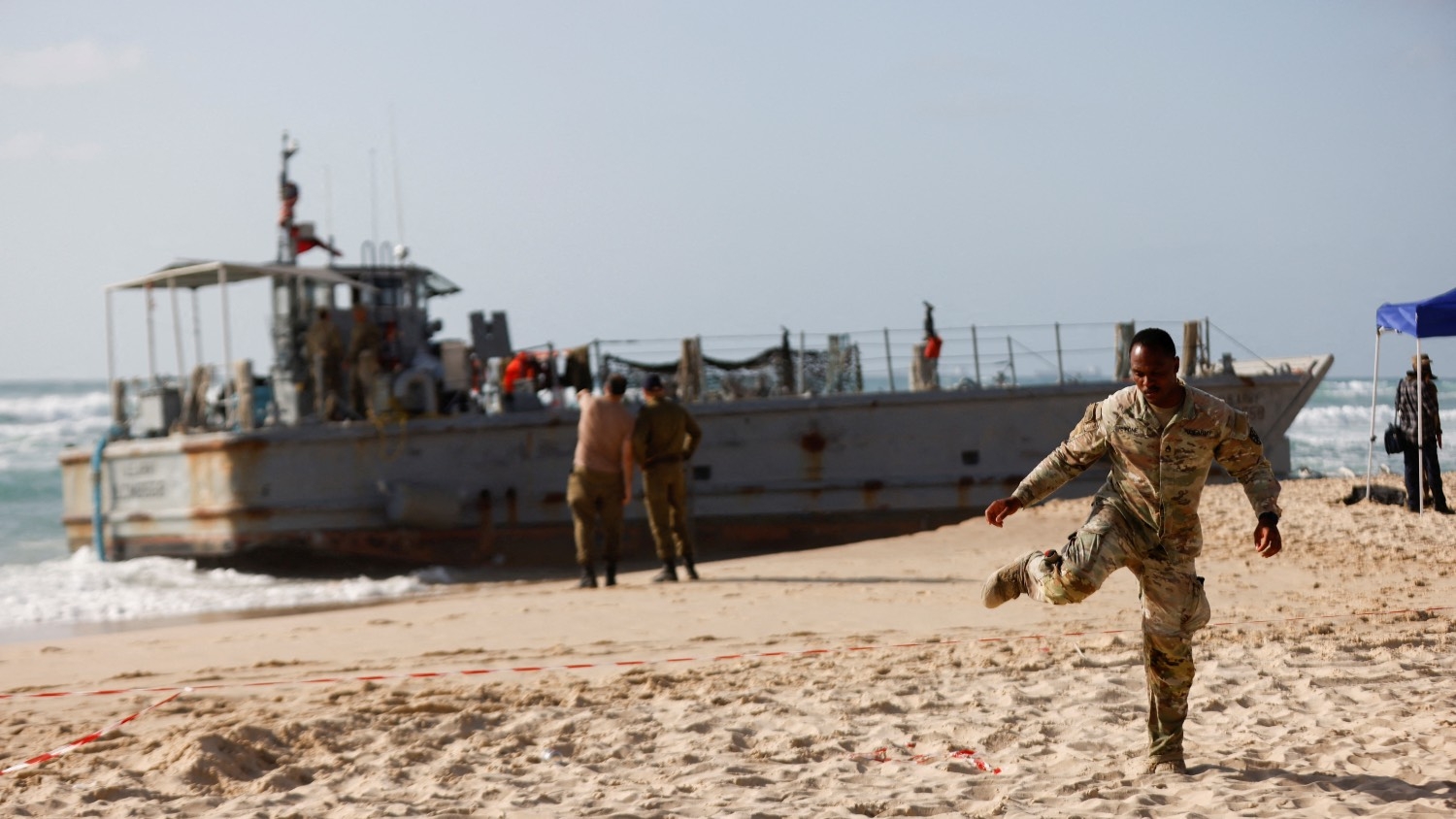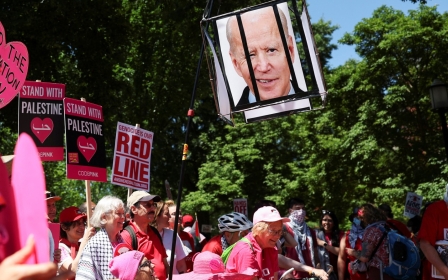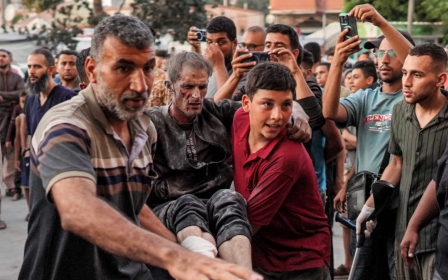The Gaza Pier: A public relations stunt doomed from the start

The US is now considering temporarily dismantling and relocating its pier off the coast of Gaza for the second time over fears of poor conditions.
After it was previously damaged and repaired two times in the past month, the US-built pier meant to deliver humanitarian aid to Palestinians now also faces the question of whether the United Nations will even continue using it to distribute aid.
The mounting obstacles set out in front of the pier in its short lifespan are demonstrative of what former US officials, aid agencies and government watchdogs say is a US public relations stunt that serves to divert attention away from Israel's ongoing destruction of Gaza, as well as Israel's restriction of aid to the strip.
"This pier has been an immense and costly distraction from the work that we need to do and the problems we need to solve," Scott Paul, who leads humanitarian policy at Oxfam, told Middle East Eye.
"This was a way of avoiding addressing the most critical obstacles to humanitarian assistance in Gaza, and so I think it's fair to say that it has not met even the administration's modest expectations for it."
New MEE newsletter: Jerusalem Dispatch
Sign up to get the latest insights and analysis on Israel-Palestine, alongside Turkey Unpacked and other MEE newsletters
Paul, like many others who have spoken our about the pier, described the effort "as humanitarian theatre and a public relations stunt".
How much aid has been delivered?
Since Israel's war on Gaza began last year, aid agencies and the United Nations have called on Israel to do more to allow aid to enter land crossings into Gaza.
Throughout the war, Israel has blocked these land crossings, and while it recently opened several up, it also captured the Rafah crossing with Egypt causing it to be shut down.
Much of the aid that organisations are trying to get into Gaza is stuck at these land crossings, where Israel's cumbersome screening process doesn't allow "dual-use" items to enter Gaza.
Despite these restrictions set in place by Israel and the ongoing humanitarian crisis in Gaza that includes a famine, US President Joe Biden's administration has placed minimal pressure on Israel to allow more aid in. In May, it released a report stating that it found no instances of Israel restricting aid to Gaza.
'The very existence of the pier is a tacit admission of what President Biden has refused to officially recognise: that the Israeli government is systematically blocking humanitarian aid'
- Annie Shiel, Center for Civilians in Conflict
Rather than putting pressure on Israel to open more land crossings, Biden announced the floating pier that would "enable a massive increase in the amount of humanitarian assistance getting into Gaza everyday".
"The very existence of the pier is a tacit admission of what President Biden has refused to officially recognise: that the Israeli government is systematically blocking humanitarian aid to starving Palestinians," said Annie Shiel, US advocacy officer for the Center for Civilians in Conflict (Civic), told MEE.
It also implies that the US is unable to convince Israel to allow more aid into the strip.
Since the announcement of the pier, aid agencies have been sceptical of its effectiveness.
"Overland routes are always going to be our primary method of delivery," said Paul from Oxfam, which decided not to use the pier to distribute aid.
"If at some point we had figured out that the pier was going to be some sort of silver bullet that solved the problems that we were facing, whether or not we would have endorsed that approach, we would have used it if it saved lives," he said, adding that it "clearly never got to the point".
The Pentagon has said that since 17 May, it has delivered 2,500 metric tonnes of aid via the pier. The figure is more than twice the amount of aid that has been airdropped by the US into Gaza but continues to be only a trickle of the amount of aid that was entering the enclave before the war. Prior to October, roughly 7,500 metric tonnes were entering Gaza daily.
"I actually think the people who worked on it were kind of happy about it because even though the plan was to provide a negligible amount of aid, they got to feel like they were contributing to getting aid to Gaza, despite the fact that it was in the context of this PR stunt," a former US official, who chose to speak on condition of anonymity, told MEE.
$320m or $230m versus 'zero or negligible dollars'
The initial cost of the floating pier was set at $320m, a price tag that was double the estimate from earlier this year, raising criticisms over the high cost for creating a new aid route when existing ones into Gaza were being blocked.
Last week, the Pentagon then announced that the estimated cost was reduced to $230m, including the repairs it had to complete, marketing the announcement as "significant savings" despite still being more than the original estimated cost reported by several news outlets as $180m.
While the exact numbers have been disputed in recent weeks, and the Pentagon has stated the current costs are only an estimate, whatever the final amount ends up being is incomparable to the cost of getting Israel to allow aid in via land routes.
"Whatever that number is, the comparison is zero dollars or negligible dollars - the dollars it would cost to hire a truck driver, pay for fuel and rent trucks and take them over land," said Paul.
Paul didn't dismiss the potential value of the pier, noting that any opportunity to get aid into Gaza should be used. But as it stands, the amount of attention and resources that have been put into this effort have resulted in a project that has consumed a lot of the attention around the humanitarian crisis while failing to alleviate it.
"But in terms of the animating considerations for all this, the animating considerations were what can we [the US] do to show publicly, to the Israelis and the world, that we are not going to sit on our hands while a famine unfolds," he said.
"There's no cost-efficient or humanitarian driven reason to invest in a pier like this, and particularly when land routes are perfectly available and the pier doesn't solve any of the problems that assistance is facing."
Bad weather
The humanitarian pier was first announced during Biden's State of the Union address in March.
While the speech made it appear that this pier was a carefully thought out plan made over several weeks, defence officials told the Wall Street Journal that the Pentagon learned about the pier only a few days beforehand and ended up "scrambling to put it in place".
"The announcement came before much or any of the planning, so there were a lot of questions," the former US official told Middle East Eye.
On 16 May, the pier was officially opened for aid distribution. Within two weeks, the pier was damaged by high seas and bad weather.
The inability to handle the sea conditions was curious, given that the Joint Logistics Over-the-Shore (JLOTS) has been used in disaster zones in the past, including to provide aid to Haiti in 2010 in the aftermath of the earthquake that hit the island.
One retired military officer told the Navy Times that JLOTS is a "small niche capability that's very, very specialized".
According to a report by CNN, officials had taken a look at weather patterns in the Mediterranean Sea, but the storm that hit and played a part in damaging the pier was unexpected.
"Taking into account weather is a fundamental part of operational planning," a former US official told MEE.
On 8 June, the pier was operational again before being shut down once more due to high sea levels.
On 11 June, the pier was back up and running. But then it had to contend with the aftermath of the massacre in the Nuseirat refugee camp.
The Nuseirat massacre
Last weekend, Israeli forces entered the Nuseirat refugee camp in central Gaza in disguise using a commercial truck. Videos of the truck, which Palestinians viewed as an aid truck, were shared on social media.
However, Israeli forces came out of the truck and launched a planned operation, which was assisted in part by the US military according to several reports, to rescue hostages. The result was the rescue of four captives, and the massacre of at least 274 Palestinians.
In the ensuing celebration by Israel and outrage from Palestinians, rights groups have called for an independent investigation into the killings.
At the end of the attack, an Israeli helicopter used to escort the hostages out of Gaza was seen parked on the beach next to the pier, calling into question whether the pier was being used for military purposes. The Pentagon has outright denied this, and the pier itself was not used to transport any Israeli military vehicles.
'Even before this weekend, there was such a huge trust deficit in what the US government was doing with the pier'
- Scott Paul, Oxfam
But the proximity of the Israeli military helicopter to the pier has raised concerns that aid trucks could become targets in the war. The World Food Programme, which had been seen according to Israeli reports as an alternative to Unrwa for distributing aid, has paused delivering aid from the pier since Sunday.
"Just as of the past weekend and the operation in Nuseirat, there are now new questions arising about the humanitarian character of the operation," Paul said.
"Even before this weekend, there was such a huge trust deficit in what the US government was doing with the pier - that anything to call into question the humanitarian character of it was not going to exacerbate a problem that already existed."
The former US official who spoke to MEE said that, given the US stance that it would have "no boots on the ground" in Gaza, the presence of Israel's military at the beach is a given.
"The plan necessitated wherever it touched ground, being secured by force," the ex-official said.
"The only force that could do that is the Israeli military. And so the unintended but very predictable consequence of that, is that you have the pier ending at an IDF [Israeli army] forward base."
As of 14 June, the temporary pier is reportedly set to be temporarily dismantled and relocated to Israel in anticipation of high seas that could cause serious damage.
Delays, repairs, suspended deliveries and a lack of aid partners have been the dominating story in the four weeks since it was launched.
Middle East Eye delivers independent and unrivalled coverage and analysis of the Middle East, North Africa and beyond. To learn more about republishing this content and the associated fees, please fill out this form. More about MEE can be found here.






